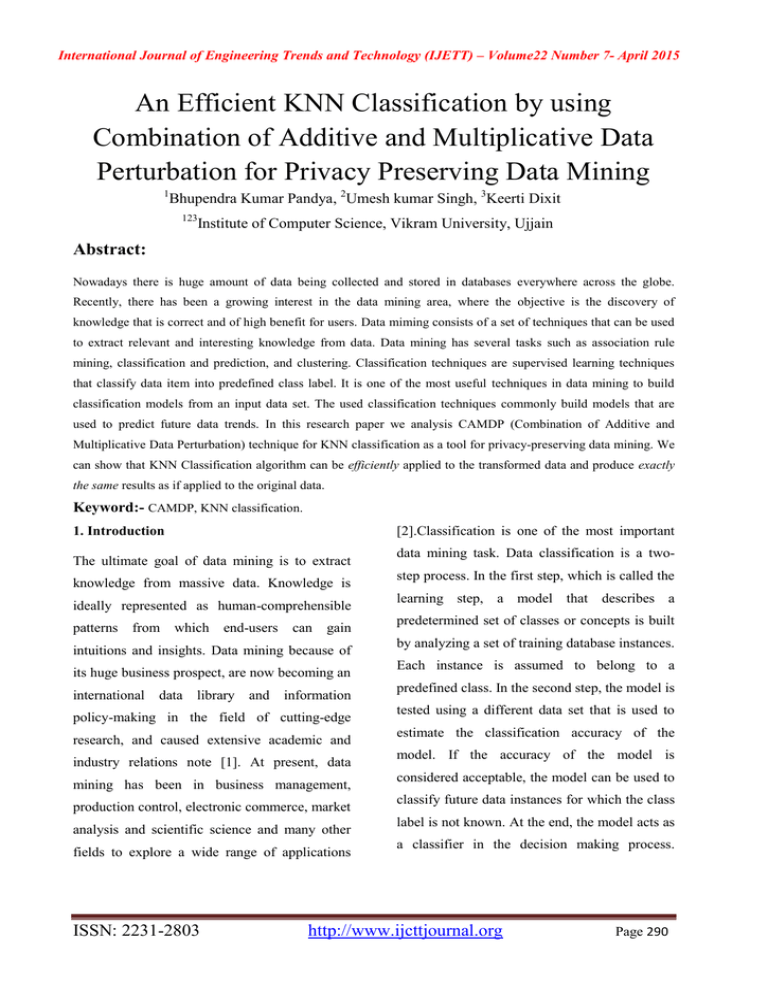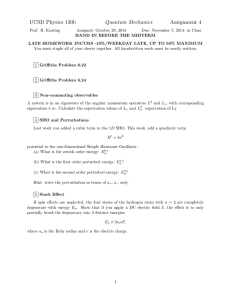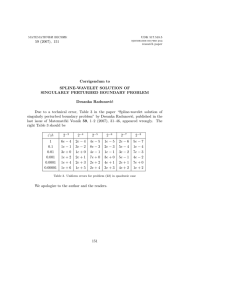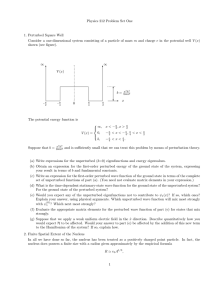An Efficient KNN Classification by using
advertisement

International Journal of Engineering Trends and Technology (IJETT) – Volume22 Number 7- April 2015 An Efficient KNN Classification by using Combination of Additive and Multiplicative Data Perturbation for Privacy Preserving Data Mining 1 Bhupendra Kumar Pandya, 2Umesh kumar Singh, 3Keerti Dixit 123 Institute of Computer Science, Vikram University, Ujjain Abstract: Nowadays there is huge amount of data being collected and stored in databases everywhere across the globe. Recently, there has been a growing interest in the data mining area, where the objective is the discovery of knowledge that is correct and of high benefit for users. Data miming consists of a set of techniques that can be used to extract relevant and interesting knowledge from data. Data mining has several tasks such as association rule mining, classification and prediction, and clustering. Classification techniques are supervised learning techniques that classify data item into predefined class label. It is one of the most useful techniques in data mining to build classification models from an input data set. The used classification techniques commonly build models that are used to predict future data trends. In this research paper we analysis CAMDP (Combination of Additive and Multiplicative Data Perturbation) technique for KNN classification as a tool for privacy-preserving data mining. We can show that KNN Classification algorithm can be efficiently applied to the transformed data and produce exactly the same results as if applied to the original data. Keyword:- CAMDP, KNN classification. [2].Classification is one of the most important 1. Introduction The ultimate goal of data mining is to extract knowledge from massive data. Knowledge is ideally represented as human-comprehensible patterns from which end-users can gain intuitions and insights. Data mining because of its huge business prospect, are now becoming an international data library and information policy-making in the field of cutting-edge research, and caused extensive academic and industry relations note [1]. At present, data mining has been in business management, production control, electronic commerce, market analysis and scientific science and many other fields to explore a wide range of applications ISSN: 2231-2803 data mining task. Data classification is a twostep process. In the first step, which is called the learning step, a model that describes a predetermined set of classes or concepts is built by analyzing a set of training database instances. Each instance is assumed to belong to a predefined class. In the second step, the model is tested using a different data set that is used to estimate the classification accuracy of the model. If the accuracy of the model is considered acceptable, the model can be used to classify future data instances for which the class label is not known. At the end, the model acts as a classifier in the decision making process. http://www.ijcttjournal.org Page 290 International Journal of Engineering Trends and Technology (IJETT) – Volume22 Number 7- April 2015 There are several techniques that can be used for denote a metric space by a 2-tuple (S, d). A classification such as decision tree, Bayesian metric space must also satisfy methods, rule based algorithms, and Neural 1. d(x, y) = 0 iff x = y (identity), Networks. In this paper, we analyze a new 2. d(x, y) = d(y, x) (symmetry), multidimensional data perturbation technique: 3. d(x, y) + d(y, z) ≥ d(x, z) (triangle inequality). CAMDP 2.3. (Combination of Additive and Multiplicative Data Perturbation) for Privacy Preserving Data Mining that can be applied for several categories of popular data mining models with better utility preservation and privacy preservation. Generation of Orthogonal Matrix Many matrix decompositions involve orthogonal matrices, such as QR decomposition, SVD, spectral decomposition decomposition. To and generate a polar uniformly distributed random orthogonal matrix, we 2. CAMDP Technique: usually fill a matrix with independent Gaussian The CAMDP technique is a Combination of Additive and Multiplicative Data Perturbation random entries, then use QR decomposition. 2.4. Data Perturbation Model techniques. This Method combines the strength of the translation and distance preserving Translation and Orthogonal transformation- method. based data perturbation can be implemented as follows. Suppose the data owner has a private 2.1. Translation Based Perturbation database Dn×n, with each column of D being a In TBP method, the observations of confidential record and each row an attribute. The data attributes are perturbed using an additive noise owner generates a n × n noise matrix OR , and perturbation. Here we apply the noise term computes applied for each confidential attribute which is D’n×n = Dn×n * ORn×n constant and value can be either positive or where ORn×n is generated by Translation and negative. Orthogonal Transformation. 2.2. The perturbed data D’n×n is then released for To Distance Based Perturbation define the distance preserving future usage. Next we describe the privacy transformation[3][4], let us start with the application scenarios definition of metric space. In mathematics, a transformation can be used to hide the data metric space is a set S with a global distance while function (the metric d) that, for every two points discovered without error. x, y in S, gives the distance between them as a This technique has a nice property that it nonnegative real number d(x, y). Usually, we preserves vector inner product and distance in allowing where important orthogonal patterns to be Euclidean space. Therefore, any data mining ISSN: 2231-2803 http://www.ijcttjournal.org Page 291 International Journal of Engineering Trends and Technology (IJETT) – Volume22 Number 7- April 2015 algorithms that rely on inner product or Intermediate Result: Noise Matrix. Euclidean distance as a similarity criteria are Output: Perturbed data stream D ’. invariant to this transformation. Put in other Steps: words, many data mining algorithms can be 1. Given input data Dn×n . applied to the transformed data and produce 2. Generate an Orthonal Matrix On×n from the exactly the same results as if applied to the Original Data Dn×n. original data, e.g., KNN classifier, perception 3. Create Translation Matrix Tn×n. learning, support vector machine, distance-based 4. Creat Matrix OTn×n by adding the Translation clustering and outlier detection. Matrix Tn×n and Orthonal Matrix On×n. 5. Generate an Orthonal Matrix(noise matrix) 3. ORn×n from the Matrix OTn×n. CAMDP Algorithm 6. Create Perturbed Dataset D’n×n by multiplying Algorithm: Privacy Preserving using CAMDP Technique. Original Data Dn×n and Noise Matrix ORn×n. 7. Release Perturbed Data for Data Miner. Input: Original Data D. 8. Stop 12 39.79 24.2 20.2 33.4 44 16.8 Comparison of Original and Perturbed Data: Original and Perturbed Data after CAMDP technique Euclidean Distance of Perturbed Data 150 32 24 12 100 18.6 26.5 18.6 17.1 39.79 24.2 48.7 27.9 20.2 17.2 11 21.8 22.8 37 12.6 33.4 44 16.8 50 Euclidean Distance of Perturbed Data 50 0 0 20 40 45 60 Original Data Perturbed Data Figure 1 Euclidean Distance -50 40 35 30 25 20 Euclidean Distance of Original Data 15 32 24 18.6 18.6 26.5 17.1 ISSN: 2231-2803 48.7 27.9 17.2 11 21.8 22.8 37 12.6 10 0 5 10 15 Seed Value 20 Figure 2 and 3 http://www.ijcttjournal.org Page 292 25 International Journal of Engineering Trends and Technology (IJETT) – Volume22 Number 7- April 2015 Euclidean Distance Euclidean Distance of Original Data 50 tree etc. And we get the same result as obtained 45 with the original data. 40 5. 35 Classification is the process of building a 30 classifier from a set of pre-classified (labelled) Classification records. It discovers a pattern (model) that 25 explains the relationship between the class and 20 the non-class attributes [5]. A classifier is then 15 10 used to assign (predict) a class attribute value to new unlabeled records. Classifiers also help to 0 5 10 15 Seed Value 20 25 analyze the data sets better. They are expressed We have taken the original data which is result in different ways such as decision trees, sets of set of students. With this data we have generated rules. a noise matrix with the help of CAMDP transformation and this resultant noise data set is One of the techniques for building decision trees multiplied with the original data set to form the is based on information gain [5,6]. This perturb data. We have plotted graph 1 that technique shows the difference between Original and (uncertainty) in estimating the class attribute Perturbed Data. We have evaluated Euclidean values in the whole data set. It then divides the Distance of original and perturbed data with whole data set into two parts, based on an pdist() fuction of Matlab. We have plotted the attribute, where each part contains a subset of graph 2 and 3 which shows the comparison values of the attribute and the other part contains between Euclidean Distances of original data the set of remaining values of the attribute. The and perturbed data after applying CAMDP attribute value that sits in the border of the two technique. sets of values is also known as the splitting first calculates the entropy point. 4. Discussion Due to the division of the data set, the The above graph shows that the Euclidean Distance among the data records are preserved after perturbation. Hence the data perturbed by CAMDP technique can be used by various data mining applications such as k-means clustering, k_nearest neighbourhood classification, decision ISSN: 2231-2803 uncertainty in estimating the class attribute value changes which depends on the distribution of the class values. For example, let us assume that the domain size of the class attribute of a data set is two. In an extreme case, if all records belonging to one division have one class value http://www.ijcttjournal.org Page 293 International Journal of Engineering Trends and Technology (IJETT) – Volume22 Number 7- April 2015 and all other records belonging to the other Classification of Original Data using KNN Classification division have the other class value then the uncertainty gets reduced to zero resulting in the 1 maximum information gain. The decision tree among all possible splitting points of all nonclass attributes, that reduces the uncertainty the most. The best splitting attribute is the root node Cluster building algorithm picks the best splitting point, 2 of a decision tree and the best splitting point is the label on the edges. The same approach is 3 applied again on each division of the data set and this process continues until the termination -0.2 condition is met, resulting in a decision tree classifier. 0 0.2 0.4 0.6 Silhouette Value 0.8 1 Classification of Perturbed Data using KNN Classification 6. Experiment result based on the KNN (k1 We have taken the original data which is result set of students and we have taken the subset of the original dataset and named it training. And Cluster nearest neighbour) classification 2 we formed the group corresponding to training dataset. We have classified the original dataset 3 in these groups on the basis of the training dataset with the knnclassify() function of -0.2 matlab. And same classification applied on the 0 0.2 0.4 0.6 Silhouette Value 0.8 1 perturbed data using the same function. We have used silhouette function for plotting graph of the classified data generated by the original data and also for plotting graph of the classified data As shown in the above graph the classification of original data and perturbed data remains same. generated by perturbed data. 7. Discussion It is proved by the experimental result that we get the same result after applying classification ISSN: 2231-2803 http://www.ijcttjournal.org Page 294 International Journal of Engineering Trends and Technology (IJETT) – Volume22 Number 7- April 2015 to the perturbed data as after applying 9. References classification to the original data. Hence we can [1] Strehl A,Ghosh J. Relationship-based clustering and say that data perturbed by this technique can be visualization used in classification techniques. mining[J].INFORMS J COMPUT,2003,15(2):208-230. for high-dimensional data [2] Milenova B.L. , Campos M.M.O-Cluster: scalable The tremendous popularity of K- nearest clustering of large high dimensional data sets[C].IEEE classification has brought to life many other International Conference on Data Mining,2002,290- extensions and modifications. Euclidean distance is an important factor in k-nearest classification. In Distance preserving 297. [3] B. Pandya,U.K.Singh and K. Dixit, “An Analysis of Euclidean Distance Presrving Perturbation for Privacy Preserving Data Mining” International Journal for Research perturbation technique the Euclidean distance is in Applied Science and Engineering Technology, Vol. 2, preserved after perturbation. Hence the data Issue X, 2014. perturbed by this technique can be used in various clustering and classification techniques. [4] B. Pandya,U.K.Singh and K. Dixit, “Performance of Euclidean Distance Presrving Perturbation for K-Nearest Neighbour 8. Conclusion In this research paper, we have analyzed the Classification” International Journal of Computer Application, Vol. 105, No. 2, pp 34-36, 2014. [5] J. Han and M. Kamber. Data Mining Concepts and effectiveness of CAMDP technique CAMDP Techniques. Morgan Kaufmann Publishers, San Diego, CA technique includes the linear combination of 92101-4495,USA, 2001. Distance Preserving perturbation and translation [6] B. Pandya,U.K.Singh and K. Dixit, “An Evaluation of perturbation. This technique allows many Projection Based Multiplicative Data Perturbation for K- interesting data mining algorithms to be applied Nearest Neighbour Classification” International Journal of directly to the perturbed data and produce an Science and Research, Vol. 3, Issue. 12, pp 681-684, 2014. error-free result, e.g., K-means clustering and Knearest neighbour classification. The tremendous popularity of KNN Classification algorithm has brought to life many other extensions and modifications. Euclidean distance is an important factor in kmeans clustering. In CAMDP technique the Euclidean distance is preserved after perturbation. Hence the data perturbed by this technique can be used in various classification techniques. ISSN: 2231-2803 http://www.ijcttjournal.org Page 295



